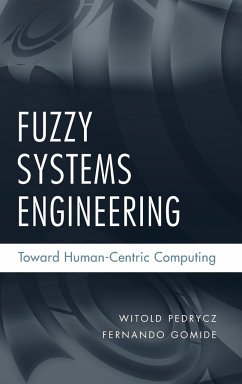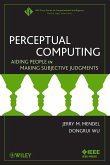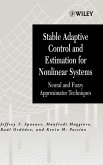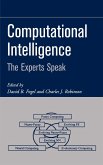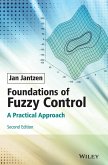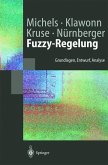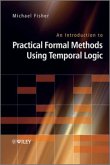Schade – dieser Artikel ist leider ausverkauft. Sobald wir wissen, ob und wann der Artikel wieder verfügbar ist, informieren wir Sie an dieser Stelle.
- Gebundenes Buch
- Merkliste
- Auf die Merkliste
- Bewerten Bewerten
- Teilen
- Produkt teilen
- Produkterinnerung
- Produkterinnerung
A radical departure from the conventional approach usually used to cover fuzzy systems engineering, Fuzzy Systems Engineering: Toward Human-Centric Computing provides a comprehensive and self-contained treatise of fuzzy sets. The author provides solid conceptual fundamentals, development guidelines, and pertinent, carefully selected illustrative material while emphasizing the role of fuzzy sets as an enabling technology whose impact, contributions, and methodology stretch far beyond any specific community and research area.
A self-contained treatment of fuzzy systems engineering, offering…mehr
Andere Kunden interessierten sich auch für
![Perceptual Computing Perceptual Computing]() Jerry MendelPerceptual Computing120,99 €
Jerry MendelPerceptual Computing120,99 €![Stable Adaptive Control and Estimation for Nonlinear Systems Stable Adaptive Control and Estimation for Nonlinear Systems]() Jeffrey T. SpoonerStable Adaptive Control and Estimation for Nonlinear Systems182,99 €
Jeffrey T. SpoonerStable Adaptive Control and Estimation for Nonlinear Systems182,99 €![Computational Intelligence Computational Intelligence]() David B. Fogel / Charles J. Robinson (Hgg.)Computational Intelligence165,99 €
David B. Fogel / Charles J. Robinson (Hgg.)Computational Intelligence165,99 €![Foundations of Fuzzy Control Foundations of Fuzzy Control]() Jan JantzenFoundations of Fuzzy Control114,99 €
Jan JantzenFoundations of Fuzzy Control114,99 €![Fuzzy-Regelung Fuzzy-Regelung]() Kai MichelsFuzzy-Regelung27,99 €
Kai MichelsFuzzy-Regelung27,99 €![Advanced Fuzzy Logic Technologies in Industrial Applications Advanced Fuzzy Logic Technologies in Industrial Applications]() Ying Bai / Hanqi Zhuang / Dali Wang (eds.)Advanced Fuzzy Logic Technologies in Industrial Applications75,99 €
Ying Bai / Hanqi Zhuang / Dali Wang (eds.)Advanced Fuzzy Logic Technologies in Industrial Applications75,99 €![An Introduction to Practical Formal Methods Using Temporal Logic An Introduction to Practical Formal Methods Using Temporal Logic]() Michael FisherAn Introduction to Practical Formal Methods Using Temporal Logic127,99 €
Michael FisherAn Introduction to Practical Formal Methods Using Temporal Logic127,99 €-
-
-
A radical departure from the conventional approach usually used to cover fuzzy systems engineering, Fuzzy Systems Engineering: Toward Human-Centric Computing provides a comprehensive and self-contained treatise of fuzzy sets. The author provides solid conceptual fundamentals, development guidelines, and pertinent, carefully selected illustrative material while emphasizing the role of fuzzy sets as an enabling technology whose impact, contributions, and methodology stretch far beyond any specific community and research area.
A self-contained treatment of fuzzy systems engineering, offering conceptual fundamentals, design methodologies, development guidelines, and carefully selected illustrative material
Forty years have passed since the birth of fuzzy sets, in which time a wealth of theoretical developments, conceptual pursuits, algorithmic environments, and other applications have emerged. Now, this reader-friendly book presents an up-to-date approach to fuzzy systems engineering, covering concepts, design methodologies, and algorithms coupled with interpretation, analysis, and underlying engineering knowledge. The result is a holistic view of fuzzy sets as a fundamental component of computational intelligence and human-centric systems.
Throughout the book, the authors emphasize the direct applicability and limitations of the concepts being discussed, and historical and bibliographical notes are included in each chapter to help readers view the developments of fuzzy sets from a broader perspective. A radical departure from current books on the subject, Fuzzy Systems Engineering presents fuzzy sets as an enabling technology whose impact, contributions, and methodology stretch far beyond any specific discipline, making it applicable to researchers and practitioners in engineering, computer science, business, medicine, bioinformatics, and computational biology. Additionally, three appendices and classroom-ready electronic resources make it an ideal textbook for advanced undergraduate- and graduate-level courses in engineering and science.
A self-contained treatment of fuzzy systems engineering, offering conceptual fundamentals, design methodologies, development guidelines, and carefully selected illustrative material
Forty years have passed since the birth of fuzzy sets, in which time a wealth of theoretical developments, conceptual pursuits, algorithmic environments, and other applications have emerged. Now, this reader-friendly book presents an up-to-date approach to fuzzy systems engineering, covering concepts, design methodologies, and algorithms coupled with interpretation, analysis, and underlying engineering knowledge. The result is a holistic view of fuzzy sets as a fundamental component of computational intelligence and human-centric systems.
Throughout the book, the authors emphasize the direct applicability and limitations of the concepts being discussed, and historical and bibliographical notes are included in each chapter to help readers view the developments of fuzzy sets from a broader perspective. A radical departure from current books on the subject, Fuzzy Systems Engineering presents fuzzy sets as an enabling technology whose impact, contributions, and methodology stretch far beyond any specific discipline, making it applicable to researchers and practitioners in engineering, computer science, business, medicine, bioinformatics, and computational biology. Additionally, three appendices and classroom-ready electronic resources make it an ideal textbook for advanced undergraduate- and graduate-level courses in engineering and science.
Produktdetails
- Produktdetails
- Wiley - IEEE 1
- Verlag: Wiley & Sons
- 1. Auflage
- Seitenzahl: 544
- Erscheinungstermin: 1. August 2007
- Englisch
- Abmessung: 240mm x 161mm x 34mm
- Gewicht: 915g
- ISBN-13: 9780471788577
- ISBN-10: 0471788570
- Artikelnr.: 22724688
- Herstellerkennzeichnung
- Libri GmbH
- Europaallee 1
- 36244 Bad Hersfeld
- gpsr@libri.de
- Wiley - IEEE 1
- Verlag: Wiley & Sons
- 1. Auflage
- Seitenzahl: 544
- Erscheinungstermin: 1. August 2007
- Englisch
- Abmessung: 240mm x 161mm x 34mm
- Gewicht: 915g
- ISBN-13: 9780471788577
- ISBN-10: 0471788570
- Artikelnr.: 22724688
- Herstellerkennzeichnung
- Libri GmbH
- Europaallee 1
- 36244 Bad Hersfeld
- gpsr@libri.de
Witold Pedrycz, PhD, is Professor and Canada Research Chair in Computational Intelligence at the University of Alberta, Canada. His research interests include granular computing, including fuzzy set technology, neural networks and evolutionary computing, pattern recognition, data mining, and emerging behavior and adaptive systems. He has authored or edited eight books, over 200 papers in journals or volumes, and over forty conference papers. He is a Fellow of the IEEE and IFSA. Fernando Gomide, PhD, teaches in the Department of Computer Engineering and Industrial Automation at the State University of Campinas (UNICAMP) in São Paulo, Brazil. His areas of interest include fuzzy sets and logic, artificial intelligence, and genetic algorithms.
Preface.
1 Introduction.
1.1 Digital communities and a fundamental quest for human-centric systems.
1.2 A historical overview: towards a non-Aristotelian perspective of the
world.
1.3 Granular Computing.
1.4 Quantifying information granularity: generality versus specificity.
1.5 Computational Intelligence.
1.6 Granular Computing and Computational Intelligence.
1.7 Conclusions.
Exercises and problems.
Historical notes.
References.
2 Notions and Concepts of Fuzzy Sets.
2.1 Sets and fuzzy sets: a departure from the principle of dichotomy.
2.2 Interpretation of fuzzy sets.
2.3 Membership functions and their motivation.
2.4 Fuzzy numbers and intervals.
2.5 Linguistic variables.
2.6 Conclusions.
Exercises and problems.
Historical notes.
References.
3 Characterization of Fuzzy Sets.
3.1 A generic characterization of fuzzy sets: some fundamental descriptors.
3.2 Equality and inclusion relationships in fuzzy sets.
3.3 Energy and entropy measures of fuzziness.
3.4 Specificity of fuzzy sets.
3.5 Geometric interpretation of sets and fuzzy sets.
3.6 Granulation of information.
3.7 Characterization of the families of fuzzy sets.
3.8 Fuzzy sets, sets, and the representation theorem.
3.9 Conclusions.
Exercises and problems.
Historical notes.
References.
4 The Design of Fuzzy Sets.
4.1 Semantics of fuzzy sets: some general observations.
4.2 Fuzzy set as a descriptor of feasible solutions.
4.3 Fuzzy set as a descriptor of the notion of typicality.
4.4 Membership functions in the visualization of preferences of solutions.
4.5 Nonlinear transformation of fuzzy sets.
4.6 Vertical and horizontal schemes of membership estimation.
4.7 Saaty's priority method of pairwise membership function estimation.
4.8 Fuzzy sets as granular representatives of numeric data.
4.9 From numeric data to fuzzy sets.
4.10 Fuzzy equalization.
4.11 Linguistic approximation.
4.12 Design guidelines for the construction of fuzzy sets.
4.13 Conclusions.
Exercises and problems.
Historical notes.
References.
5 Operations and Aggregations of Fuzzy Sets.
5.1 Standard operations on sets and fuzzy sets.
5.2 Generic requirements for operations on fuzzy sets.
5.3 Triangular norms.
5.4 Triangular conorms.
5.5 Triangular norms as a general category of logical operators.
5.6 Aggregation operations.
5.7 Fuzzy measure and integral.
5.8 Negations.
5.9 Conclusions.
Exercises and problems.
Historical notes.
References.
6 Fuzzy Relations.
6.1 The concept of relations.
6.2 Fuzzy relations.
6.3 Properties of the fuzzy relations.
6.4 Operations on fuzzy relations.
6.5 Cartesian product, projections and cylindrical extension of fuzzy sets.
6.6 Reconstruction of fuzzy relations.
6.7 Binary fuzzy relations.
6.8 Conclusions.
Exercises and problems.
Historical notes.
References.
7 Transformations of Fuzzy Sets.
7.1 The extension principle.
7.2 Compositions of fuzzy relations.
7.3 Fuzzy relational equations.
7.4 Associative Memories.
7.5 Fuzzy numbers and fuzzy arithmetic.
7.6 Conclusions.
Exercises and problems.
Historical notes.
References.
8 Generalizations and Extensions of Fuzzy Sets.
8.1 Fuzzy sets of higher order.
8.2 Rough fuzzy sets and fuzzy rough sets.
8.3 Interval-valued fuzzy sets.
8.4 Type-2 fuzzy sets.
8.5 Shadowed sets as a three-valued logic characterization of fuzzy sets.
8.6 Probability and fuzzy sets.
8.7 Probability of fuzzy events.
8.8 Conclusions.
Exercises and problems.
Historical notes.
References.
9 Interoperability Aspects of Fuzzy Sets.
9.1 Fuzzy set and its family of s-cuts.
9.2 Fuzzy sets and their interfacing with the external world.
9.3 Encoding and decoding as an optimization problem of vector
quantization.
9.4 Decoding of a fuzzy set through a family of fuzzy sets.
9.5 Taxonomy of data in structure description with shadowed sets.
9.6 Conclusions.
Exercises and problems.
Historical notes.
References.
10. Fuzzy Modeling: Principles and Methodology.
10.1 The architectural blueprint of fuzzy models.
10.2 Key phases of the development and use of fuzzy models.
10.3 Main categories of fuzzy models: an overview.
10.4 Verification and validation of fuzzy models.
10.5 Conclusions.
Exercises and problems.
Historical notes.
References.
11 Rule-based Fuzzy Models.
11.1 Fuzzy rules as a vehicle of knowledge representation.
11.2 General categories of fuzzy rules and their semantics.
11.3 Syntax of fuzzy rules.
11.4 Basic Functional Modules: Rule base, Database, and Inference scheme.
11.5 Types of Rule-Based Systems and Architectures.
11.6 Approximation properties of fuzzy rule-based models.
11.7 Development of Rule-Based Systems.
11.8 Parameter estimation procedure for functional rule-based systems.
11.9 Design issues of rule-based systems - consistency, completeness, and
the curse of dimensionality.
11.10 The curse of dimensionality in rule-based systems.
11.11 Development scheme of fuzzy rule-based models.
11.12 Conclusions.
Exercises and problems.
Historical notes.
References.
12 From Logic Expressions to Fuzzy Logic Networks.
12.1 Introduction.
12.2 Main categories of fuzzy neurons.
12.3 Uninorm-based fuzzy neurons.
12.4 Architectures of logic networks.
12.5 The development mechanisms of the fuzzy neural networks.
12.6 Interpretation of the fuzzy neural networks.
12.7 From fuzzy logic networks to Boolean functions and their minimization
through learning.
12.8 Interfacing the fuzzy neural network.
12.9 Interpretation aspects - a refinement of induced rule-based system.
12.10 Reconciliation of perception of information granules and granular
mappings.
12.11 Conclusions.
Exercises and problems.
Historical notes.
References.
13. Fuzzy Systems and Computational Intelligence.
13.1 Computational Intelligence.
13.2 Recurrent neurofuzzy systems.
13.3 Genetic fuzzy systems.
13.4 Coevolutionary hierarchical genetic fuzzy system.
13.5 Hierarchical collaborative relations.
13.6 Evolving fuzzy systems.
13.7 Conclusions.
Exercises and problems.
Historical notes.
References.
14. Granular Models and Human Centric Computing.
14.1 The cluster-based representation of the input - output mappings.
14.2 Context-based clustering in the development of granular models.
14.3 Granular neuron as a generic processing element in granular networks.
14.4 Architecture of granular models based on conditional fuzzy clustering.
14.5 Refinements of granular models.
14.6 Incremental granular models.
14.7 Human-centric fuzzy clustering.
14.8 Participatory learning in fuzzy clustering.
14.9 Conclusions.
Exercises and problems.
Historical notes.
References.
15. Emerging Trends in Fuzzy Systems.
15.1 Relational ontology in information retrieval.
15.2 Multiagent fuzzy systems.
15.3 Distributed fuzzy control.
15.4 Conclusions.
Exercises and problems.
Historical notes.
References.
Appendix A: Mathematical Prerequisites.
Appendix B: Neurocomputing.
Appendix C: Biologically Inspired Optimization.
Index.
1 Introduction.
1.1 Digital communities and a fundamental quest for human-centric systems.
1.2 A historical overview: towards a non-Aristotelian perspective of the
world.
1.3 Granular Computing.
1.4 Quantifying information granularity: generality versus specificity.
1.5 Computational Intelligence.
1.6 Granular Computing and Computational Intelligence.
1.7 Conclusions.
Exercises and problems.
Historical notes.
References.
2 Notions and Concepts of Fuzzy Sets.
2.1 Sets and fuzzy sets: a departure from the principle of dichotomy.
2.2 Interpretation of fuzzy sets.
2.3 Membership functions and their motivation.
2.4 Fuzzy numbers and intervals.
2.5 Linguistic variables.
2.6 Conclusions.
Exercises and problems.
Historical notes.
References.
3 Characterization of Fuzzy Sets.
3.1 A generic characterization of fuzzy sets: some fundamental descriptors.
3.2 Equality and inclusion relationships in fuzzy sets.
3.3 Energy and entropy measures of fuzziness.
3.4 Specificity of fuzzy sets.
3.5 Geometric interpretation of sets and fuzzy sets.
3.6 Granulation of information.
3.7 Characterization of the families of fuzzy sets.
3.8 Fuzzy sets, sets, and the representation theorem.
3.9 Conclusions.
Exercises and problems.
Historical notes.
References.
4 The Design of Fuzzy Sets.
4.1 Semantics of fuzzy sets: some general observations.
4.2 Fuzzy set as a descriptor of feasible solutions.
4.3 Fuzzy set as a descriptor of the notion of typicality.
4.4 Membership functions in the visualization of preferences of solutions.
4.5 Nonlinear transformation of fuzzy sets.
4.6 Vertical and horizontal schemes of membership estimation.
4.7 Saaty's priority method of pairwise membership function estimation.
4.8 Fuzzy sets as granular representatives of numeric data.
4.9 From numeric data to fuzzy sets.
4.10 Fuzzy equalization.
4.11 Linguistic approximation.
4.12 Design guidelines for the construction of fuzzy sets.
4.13 Conclusions.
Exercises and problems.
Historical notes.
References.
5 Operations and Aggregations of Fuzzy Sets.
5.1 Standard operations on sets and fuzzy sets.
5.2 Generic requirements for operations on fuzzy sets.
5.3 Triangular norms.
5.4 Triangular conorms.
5.5 Triangular norms as a general category of logical operators.
5.6 Aggregation operations.
5.7 Fuzzy measure and integral.
5.8 Negations.
5.9 Conclusions.
Exercises and problems.
Historical notes.
References.
6 Fuzzy Relations.
6.1 The concept of relations.
6.2 Fuzzy relations.
6.3 Properties of the fuzzy relations.
6.4 Operations on fuzzy relations.
6.5 Cartesian product, projections and cylindrical extension of fuzzy sets.
6.6 Reconstruction of fuzzy relations.
6.7 Binary fuzzy relations.
6.8 Conclusions.
Exercises and problems.
Historical notes.
References.
7 Transformations of Fuzzy Sets.
7.1 The extension principle.
7.2 Compositions of fuzzy relations.
7.3 Fuzzy relational equations.
7.4 Associative Memories.
7.5 Fuzzy numbers and fuzzy arithmetic.
7.6 Conclusions.
Exercises and problems.
Historical notes.
References.
8 Generalizations and Extensions of Fuzzy Sets.
8.1 Fuzzy sets of higher order.
8.2 Rough fuzzy sets and fuzzy rough sets.
8.3 Interval-valued fuzzy sets.
8.4 Type-2 fuzzy sets.
8.5 Shadowed sets as a three-valued logic characterization of fuzzy sets.
8.6 Probability and fuzzy sets.
8.7 Probability of fuzzy events.
8.8 Conclusions.
Exercises and problems.
Historical notes.
References.
9 Interoperability Aspects of Fuzzy Sets.
9.1 Fuzzy set and its family of s-cuts.
9.2 Fuzzy sets and their interfacing with the external world.
9.3 Encoding and decoding as an optimization problem of vector
quantization.
9.4 Decoding of a fuzzy set through a family of fuzzy sets.
9.5 Taxonomy of data in structure description with shadowed sets.
9.6 Conclusions.
Exercises and problems.
Historical notes.
References.
10. Fuzzy Modeling: Principles and Methodology.
10.1 The architectural blueprint of fuzzy models.
10.2 Key phases of the development and use of fuzzy models.
10.3 Main categories of fuzzy models: an overview.
10.4 Verification and validation of fuzzy models.
10.5 Conclusions.
Exercises and problems.
Historical notes.
References.
11 Rule-based Fuzzy Models.
11.1 Fuzzy rules as a vehicle of knowledge representation.
11.2 General categories of fuzzy rules and their semantics.
11.3 Syntax of fuzzy rules.
11.4 Basic Functional Modules: Rule base, Database, and Inference scheme.
11.5 Types of Rule-Based Systems and Architectures.
11.6 Approximation properties of fuzzy rule-based models.
11.7 Development of Rule-Based Systems.
11.8 Parameter estimation procedure for functional rule-based systems.
11.9 Design issues of rule-based systems - consistency, completeness, and
the curse of dimensionality.
11.10 The curse of dimensionality in rule-based systems.
11.11 Development scheme of fuzzy rule-based models.
11.12 Conclusions.
Exercises and problems.
Historical notes.
References.
12 From Logic Expressions to Fuzzy Logic Networks.
12.1 Introduction.
12.2 Main categories of fuzzy neurons.
12.3 Uninorm-based fuzzy neurons.
12.4 Architectures of logic networks.
12.5 The development mechanisms of the fuzzy neural networks.
12.6 Interpretation of the fuzzy neural networks.
12.7 From fuzzy logic networks to Boolean functions and their minimization
through learning.
12.8 Interfacing the fuzzy neural network.
12.9 Interpretation aspects - a refinement of induced rule-based system.
12.10 Reconciliation of perception of information granules and granular
mappings.
12.11 Conclusions.
Exercises and problems.
Historical notes.
References.
13. Fuzzy Systems and Computational Intelligence.
13.1 Computational Intelligence.
13.2 Recurrent neurofuzzy systems.
13.3 Genetic fuzzy systems.
13.4 Coevolutionary hierarchical genetic fuzzy system.
13.5 Hierarchical collaborative relations.
13.6 Evolving fuzzy systems.
13.7 Conclusions.
Exercises and problems.
Historical notes.
References.
14. Granular Models and Human Centric Computing.
14.1 The cluster-based representation of the input - output mappings.
14.2 Context-based clustering in the development of granular models.
14.3 Granular neuron as a generic processing element in granular networks.
14.4 Architecture of granular models based on conditional fuzzy clustering.
14.5 Refinements of granular models.
14.6 Incremental granular models.
14.7 Human-centric fuzzy clustering.
14.8 Participatory learning in fuzzy clustering.
14.9 Conclusions.
Exercises and problems.
Historical notes.
References.
15. Emerging Trends in Fuzzy Systems.
15.1 Relational ontology in information retrieval.
15.2 Multiagent fuzzy systems.
15.3 Distributed fuzzy control.
15.4 Conclusions.
Exercises and problems.
Historical notes.
References.
Appendix A: Mathematical Prerequisites.
Appendix B: Neurocomputing.
Appendix C: Biologically Inspired Optimization.
Index.
Preface.
1 Introduction.
1.1 Digital communities and a fundamental quest for human-centric systems.
1.2 A historical overview: towards a non-Aristotelian perspective of the
world.
1.3 Granular Computing.
1.4 Quantifying information granularity: generality versus specificity.
1.5 Computational Intelligence.
1.6 Granular Computing and Computational Intelligence.
1.7 Conclusions.
Exercises and problems.
Historical notes.
References.
2 Notions and Concepts of Fuzzy Sets.
2.1 Sets and fuzzy sets: a departure from the principle of dichotomy.
2.2 Interpretation of fuzzy sets.
2.3 Membership functions and their motivation.
2.4 Fuzzy numbers and intervals.
2.5 Linguistic variables.
2.6 Conclusions.
Exercises and problems.
Historical notes.
References.
3 Characterization of Fuzzy Sets.
3.1 A generic characterization of fuzzy sets: some fundamental descriptors.
3.2 Equality and inclusion relationships in fuzzy sets.
3.3 Energy and entropy measures of fuzziness.
3.4 Specificity of fuzzy sets.
3.5 Geometric interpretation of sets and fuzzy sets.
3.6 Granulation of information.
3.7 Characterization of the families of fuzzy sets.
3.8 Fuzzy sets, sets, and the representation theorem.
3.9 Conclusions.
Exercises and problems.
Historical notes.
References.
4 The Design of Fuzzy Sets.
4.1 Semantics of fuzzy sets: some general observations.
4.2 Fuzzy set as a descriptor of feasible solutions.
4.3 Fuzzy set as a descriptor of the notion of typicality.
4.4 Membership functions in the visualization of preferences of solutions.
4.5 Nonlinear transformation of fuzzy sets.
4.6 Vertical and horizontal schemes of membership estimation.
4.7 Saaty's priority method of pairwise membership function estimation.
4.8 Fuzzy sets as granular representatives of numeric data.
4.9 From numeric data to fuzzy sets.
4.10 Fuzzy equalization.
4.11 Linguistic approximation.
4.12 Design guidelines for the construction of fuzzy sets.
4.13 Conclusions.
Exercises and problems.
Historical notes.
References.
5 Operations and Aggregations of Fuzzy Sets.
5.1 Standard operations on sets and fuzzy sets.
5.2 Generic requirements for operations on fuzzy sets.
5.3 Triangular norms.
5.4 Triangular conorms.
5.5 Triangular norms as a general category of logical operators.
5.6 Aggregation operations.
5.7 Fuzzy measure and integral.
5.8 Negations.
5.9 Conclusions.
Exercises and problems.
Historical notes.
References.
6 Fuzzy Relations.
6.1 The concept of relations.
6.2 Fuzzy relations.
6.3 Properties of the fuzzy relations.
6.4 Operations on fuzzy relations.
6.5 Cartesian product, projections and cylindrical extension of fuzzy sets.
6.6 Reconstruction of fuzzy relations.
6.7 Binary fuzzy relations.
6.8 Conclusions.
Exercises and problems.
Historical notes.
References.
7 Transformations of Fuzzy Sets.
7.1 The extension principle.
7.2 Compositions of fuzzy relations.
7.3 Fuzzy relational equations.
7.4 Associative Memories.
7.5 Fuzzy numbers and fuzzy arithmetic.
7.6 Conclusions.
Exercises and problems.
Historical notes.
References.
8 Generalizations and Extensions of Fuzzy Sets.
8.1 Fuzzy sets of higher order.
8.2 Rough fuzzy sets and fuzzy rough sets.
8.3 Interval-valued fuzzy sets.
8.4 Type-2 fuzzy sets.
8.5 Shadowed sets as a three-valued logic characterization of fuzzy sets.
8.6 Probability and fuzzy sets.
8.7 Probability of fuzzy events.
8.8 Conclusions.
Exercises and problems.
Historical notes.
References.
9 Interoperability Aspects of Fuzzy Sets.
9.1 Fuzzy set and its family of s-cuts.
9.2 Fuzzy sets and their interfacing with the external world.
9.3 Encoding and decoding as an optimization problem of vector
quantization.
9.4 Decoding of a fuzzy set through a family of fuzzy sets.
9.5 Taxonomy of data in structure description with shadowed sets.
9.6 Conclusions.
Exercises and problems.
Historical notes.
References.
10. Fuzzy Modeling: Principles and Methodology.
10.1 The architectural blueprint of fuzzy models.
10.2 Key phases of the development and use of fuzzy models.
10.3 Main categories of fuzzy models: an overview.
10.4 Verification and validation of fuzzy models.
10.5 Conclusions.
Exercises and problems.
Historical notes.
References.
11 Rule-based Fuzzy Models.
11.1 Fuzzy rules as a vehicle of knowledge representation.
11.2 General categories of fuzzy rules and their semantics.
11.3 Syntax of fuzzy rules.
11.4 Basic Functional Modules: Rule base, Database, and Inference scheme.
11.5 Types of Rule-Based Systems and Architectures.
11.6 Approximation properties of fuzzy rule-based models.
11.7 Development of Rule-Based Systems.
11.8 Parameter estimation procedure for functional rule-based systems.
11.9 Design issues of rule-based systems - consistency, completeness, and
the curse of dimensionality.
11.10 The curse of dimensionality in rule-based systems.
11.11 Development scheme of fuzzy rule-based models.
11.12 Conclusions.
Exercises and problems.
Historical notes.
References.
12 From Logic Expressions to Fuzzy Logic Networks.
12.1 Introduction.
12.2 Main categories of fuzzy neurons.
12.3 Uninorm-based fuzzy neurons.
12.4 Architectures of logic networks.
12.5 The development mechanisms of the fuzzy neural networks.
12.6 Interpretation of the fuzzy neural networks.
12.7 From fuzzy logic networks to Boolean functions and their minimization
through learning.
12.8 Interfacing the fuzzy neural network.
12.9 Interpretation aspects - a refinement of induced rule-based system.
12.10 Reconciliation of perception of information granules and granular
mappings.
12.11 Conclusions.
Exercises and problems.
Historical notes.
References.
13. Fuzzy Systems and Computational Intelligence.
13.1 Computational Intelligence.
13.2 Recurrent neurofuzzy systems.
13.3 Genetic fuzzy systems.
13.4 Coevolutionary hierarchical genetic fuzzy system.
13.5 Hierarchical collaborative relations.
13.6 Evolving fuzzy systems.
13.7 Conclusions.
Exercises and problems.
Historical notes.
References.
14. Granular Models and Human Centric Computing.
14.1 The cluster-based representation of the input - output mappings.
14.2 Context-based clustering in the development of granular models.
14.3 Granular neuron as a generic processing element in granular networks.
14.4 Architecture of granular models based on conditional fuzzy clustering.
14.5 Refinements of granular models.
14.6 Incremental granular models.
14.7 Human-centric fuzzy clustering.
14.8 Participatory learning in fuzzy clustering.
14.9 Conclusions.
Exercises and problems.
Historical notes.
References.
15. Emerging Trends in Fuzzy Systems.
15.1 Relational ontology in information retrieval.
15.2 Multiagent fuzzy systems.
15.3 Distributed fuzzy control.
15.4 Conclusions.
Exercises and problems.
Historical notes.
References.
Appendix A: Mathematical Prerequisites.
Appendix B: Neurocomputing.
Appendix C: Biologically Inspired Optimization.
Index.
1 Introduction.
1.1 Digital communities and a fundamental quest for human-centric systems.
1.2 A historical overview: towards a non-Aristotelian perspective of the
world.
1.3 Granular Computing.
1.4 Quantifying information granularity: generality versus specificity.
1.5 Computational Intelligence.
1.6 Granular Computing and Computational Intelligence.
1.7 Conclusions.
Exercises and problems.
Historical notes.
References.
2 Notions and Concepts of Fuzzy Sets.
2.1 Sets and fuzzy sets: a departure from the principle of dichotomy.
2.2 Interpretation of fuzzy sets.
2.3 Membership functions and their motivation.
2.4 Fuzzy numbers and intervals.
2.5 Linguistic variables.
2.6 Conclusions.
Exercises and problems.
Historical notes.
References.
3 Characterization of Fuzzy Sets.
3.1 A generic characterization of fuzzy sets: some fundamental descriptors.
3.2 Equality and inclusion relationships in fuzzy sets.
3.3 Energy and entropy measures of fuzziness.
3.4 Specificity of fuzzy sets.
3.5 Geometric interpretation of sets and fuzzy sets.
3.6 Granulation of information.
3.7 Characterization of the families of fuzzy sets.
3.8 Fuzzy sets, sets, and the representation theorem.
3.9 Conclusions.
Exercises and problems.
Historical notes.
References.
4 The Design of Fuzzy Sets.
4.1 Semantics of fuzzy sets: some general observations.
4.2 Fuzzy set as a descriptor of feasible solutions.
4.3 Fuzzy set as a descriptor of the notion of typicality.
4.4 Membership functions in the visualization of preferences of solutions.
4.5 Nonlinear transformation of fuzzy sets.
4.6 Vertical and horizontal schemes of membership estimation.
4.7 Saaty's priority method of pairwise membership function estimation.
4.8 Fuzzy sets as granular representatives of numeric data.
4.9 From numeric data to fuzzy sets.
4.10 Fuzzy equalization.
4.11 Linguistic approximation.
4.12 Design guidelines for the construction of fuzzy sets.
4.13 Conclusions.
Exercises and problems.
Historical notes.
References.
5 Operations and Aggregations of Fuzzy Sets.
5.1 Standard operations on sets and fuzzy sets.
5.2 Generic requirements for operations on fuzzy sets.
5.3 Triangular norms.
5.4 Triangular conorms.
5.5 Triangular norms as a general category of logical operators.
5.6 Aggregation operations.
5.7 Fuzzy measure and integral.
5.8 Negations.
5.9 Conclusions.
Exercises and problems.
Historical notes.
References.
6 Fuzzy Relations.
6.1 The concept of relations.
6.2 Fuzzy relations.
6.3 Properties of the fuzzy relations.
6.4 Operations on fuzzy relations.
6.5 Cartesian product, projections and cylindrical extension of fuzzy sets.
6.6 Reconstruction of fuzzy relations.
6.7 Binary fuzzy relations.
6.8 Conclusions.
Exercises and problems.
Historical notes.
References.
7 Transformations of Fuzzy Sets.
7.1 The extension principle.
7.2 Compositions of fuzzy relations.
7.3 Fuzzy relational equations.
7.4 Associative Memories.
7.5 Fuzzy numbers and fuzzy arithmetic.
7.6 Conclusions.
Exercises and problems.
Historical notes.
References.
8 Generalizations and Extensions of Fuzzy Sets.
8.1 Fuzzy sets of higher order.
8.2 Rough fuzzy sets and fuzzy rough sets.
8.3 Interval-valued fuzzy sets.
8.4 Type-2 fuzzy sets.
8.5 Shadowed sets as a three-valued logic characterization of fuzzy sets.
8.6 Probability and fuzzy sets.
8.7 Probability of fuzzy events.
8.8 Conclusions.
Exercises and problems.
Historical notes.
References.
9 Interoperability Aspects of Fuzzy Sets.
9.1 Fuzzy set and its family of s-cuts.
9.2 Fuzzy sets and their interfacing with the external world.
9.3 Encoding and decoding as an optimization problem of vector
quantization.
9.4 Decoding of a fuzzy set through a family of fuzzy sets.
9.5 Taxonomy of data in structure description with shadowed sets.
9.6 Conclusions.
Exercises and problems.
Historical notes.
References.
10. Fuzzy Modeling: Principles and Methodology.
10.1 The architectural blueprint of fuzzy models.
10.2 Key phases of the development and use of fuzzy models.
10.3 Main categories of fuzzy models: an overview.
10.4 Verification and validation of fuzzy models.
10.5 Conclusions.
Exercises and problems.
Historical notes.
References.
11 Rule-based Fuzzy Models.
11.1 Fuzzy rules as a vehicle of knowledge representation.
11.2 General categories of fuzzy rules and their semantics.
11.3 Syntax of fuzzy rules.
11.4 Basic Functional Modules: Rule base, Database, and Inference scheme.
11.5 Types of Rule-Based Systems and Architectures.
11.6 Approximation properties of fuzzy rule-based models.
11.7 Development of Rule-Based Systems.
11.8 Parameter estimation procedure for functional rule-based systems.
11.9 Design issues of rule-based systems - consistency, completeness, and
the curse of dimensionality.
11.10 The curse of dimensionality in rule-based systems.
11.11 Development scheme of fuzzy rule-based models.
11.12 Conclusions.
Exercises and problems.
Historical notes.
References.
12 From Logic Expressions to Fuzzy Logic Networks.
12.1 Introduction.
12.2 Main categories of fuzzy neurons.
12.3 Uninorm-based fuzzy neurons.
12.4 Architectures of logic networks.
12.5 The development mechanisms of the fuzzy neural networks.
12.6 Interpretation of the fuzzy neural networks.
12.7 From fuzzy logic networks to Boolean functions and their minimization
through learning.
12.8 Interfacing the fuzzy neural network.
12.9 Interpretation aspects - a refinement of induced rule-based system.
12.10 Reconciliation of perception of information granules and granular
mappings.
12.11 Conclusions.
Exercises and problems.
Historical notes.
References.
13. Fuzzy Systems and Computational Intelligence.
13.1 Computational Intelligence.
13.2 Recurrent neurofuzzy systems.
13.3 Genetic fuzzy systems.
13.4 Coevolutionary hierarchical genetic fuzzy system.
13.5 Hierarchical collaborative relations.
13.6 Evolving fuzzy systems.
13.7 Conclusions.
Exercises and problems.
Historical notes.
References.
14. Granular Models and Human Centric Computing.
14.1 The cluster-based representation of the input - output mappings.
14.2 Context-based clustering in the development of granular models.
14.3 Granular neuron as a generic processing element in granular networks.
14.4 Architecture of granular models based on conditional fuzzy clustering.
14.5 Refinements of granular models.
14.6 Incremental granular models.
14.7 Human-centric fuzzy clustering.
14.8 Participatory learning in fuzzy clustering.
14.9 Conclusions.
Exercises and problems.
Historical notes.
References.
15. Emerging Trends in Fuzzy Systems.
15.1 Relational ontology in information retrieval.
15.2 Multiagent fuzzy systems.
15.3 Distributed fuzzy control.
15.4 Conclusions.
Exercises and problems.
Historical notes.
References.
Appendix A: Mathematical Prerequisites.
Appendix B: Neurocomputing.
Appendix C: Biologically Inspired Optimization.
Index.

